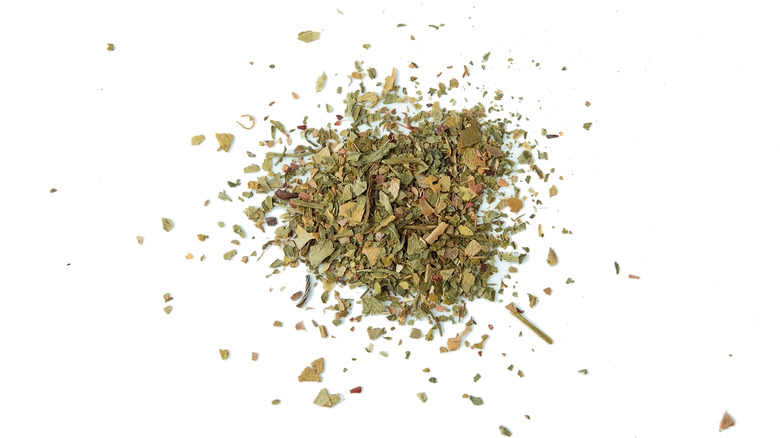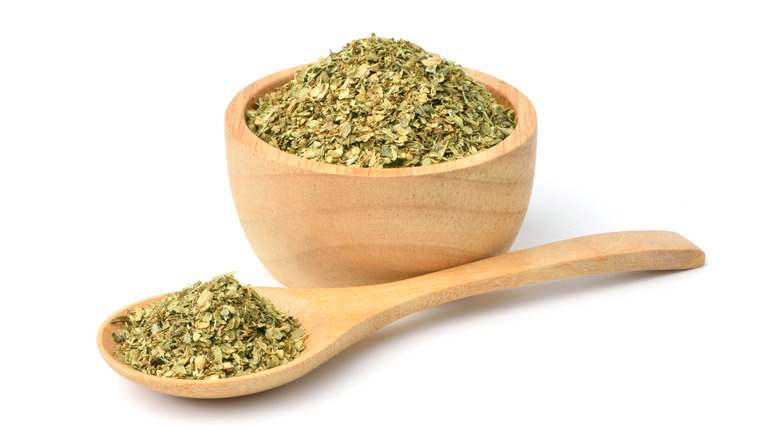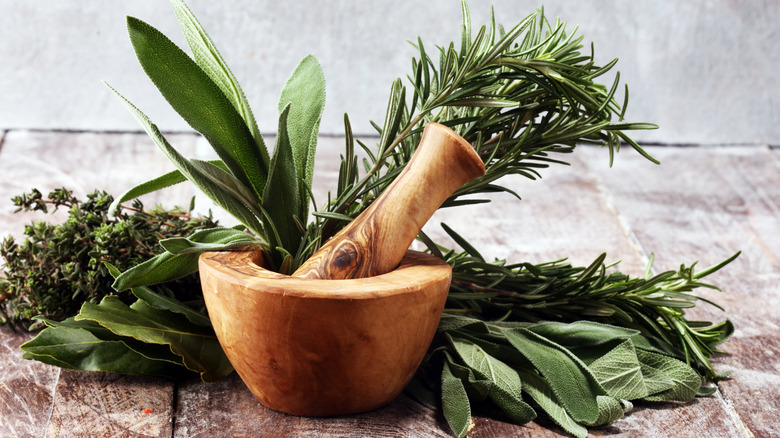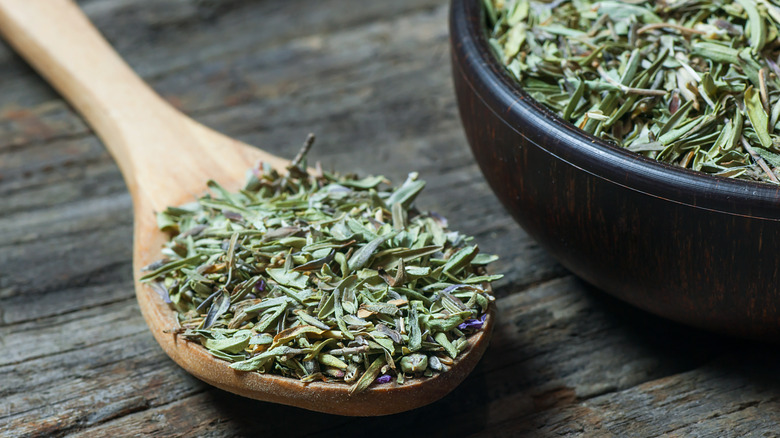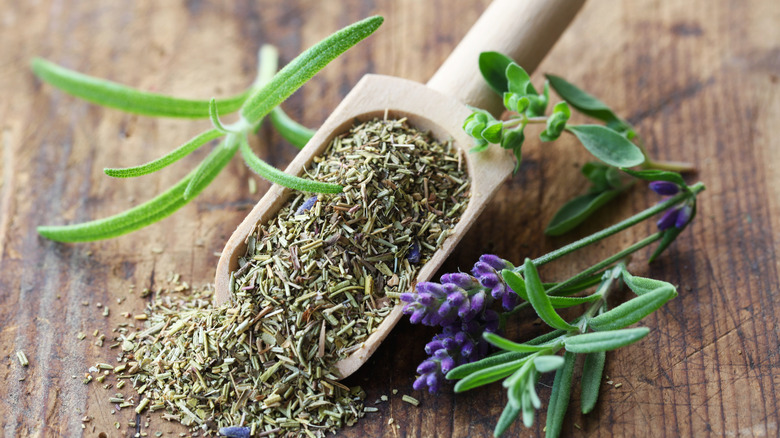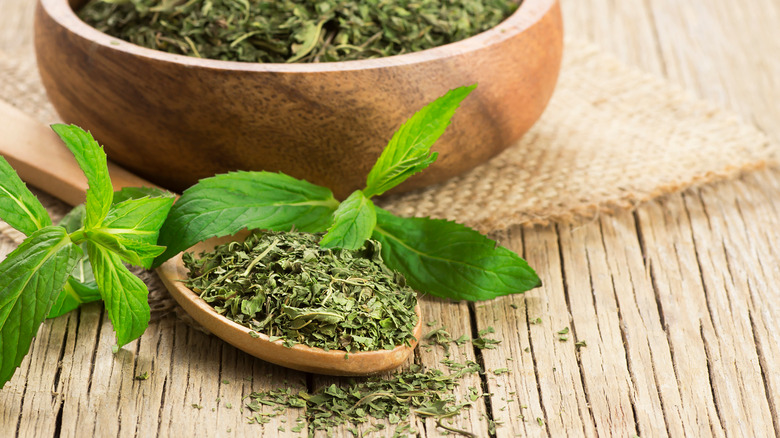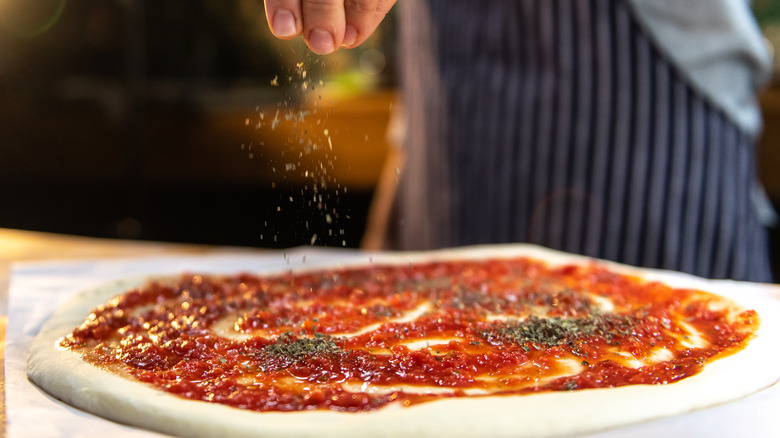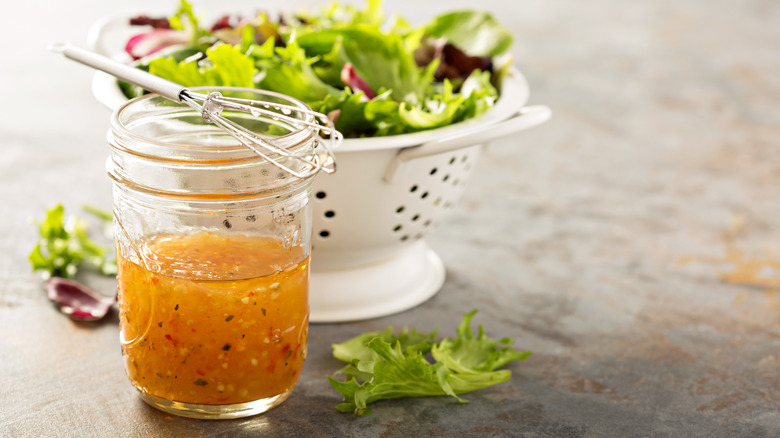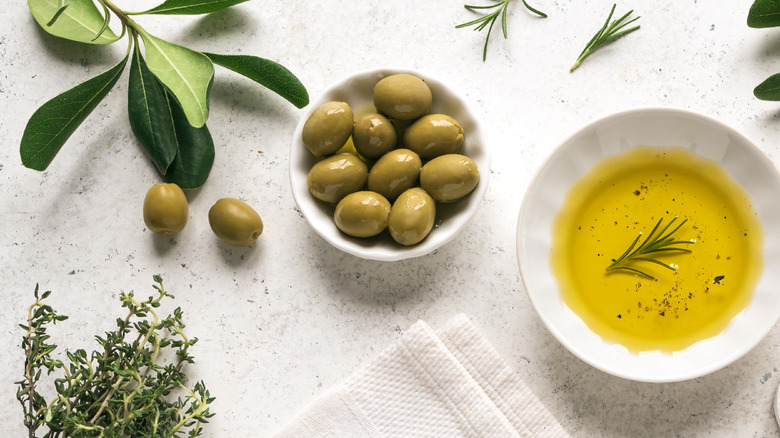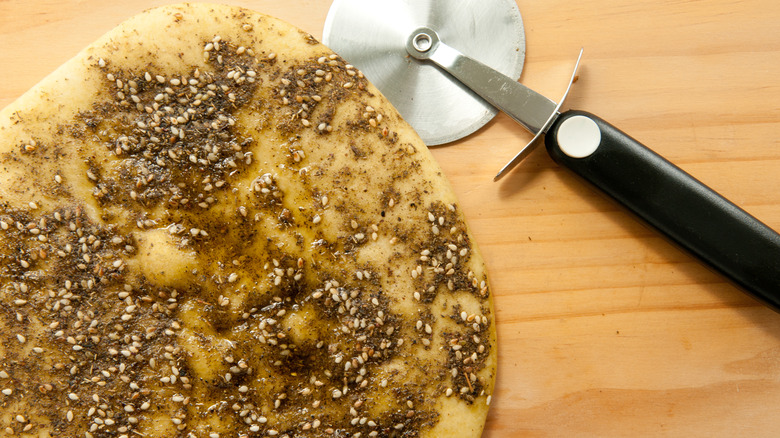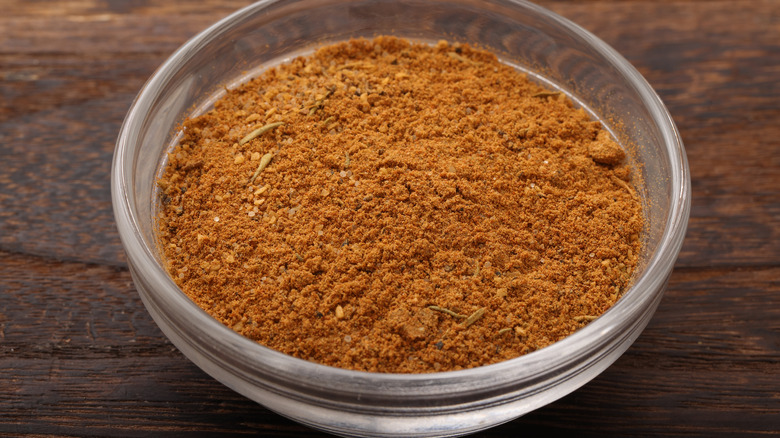10 Best Substitutes For Italian Seasoning
If you love to cook Italian-American favorites like lasagna, meatballs, and chicken parmesan, then Italian seasoning is probably one of your kitchen must-haves. The versatile, piney, and peppery blend of dried herbs can be used not only in red sauce, but also as a dry rub for pretty much any protein and even as a savory topping for breads like focaccia. But did you know that Italian seasoning isn't Italian at all?
That's right, you won't find many cooks using Italian seasoning in Italy. It's commonly believed that the ancient Greeks and Romans developed the spice blend, says the Food Network, and today, most Italians use fresh herbs in their cooking. However, the ingredients — basil, oregano, rosemary, thyme, marjoram, and sometimes more, depending on the brand — in the American-loved seasoning are definitely authentic to Italian cuisine.
Stateside, we've probably all had a time when we pulled out a shaker of Italian seasoning to use in Grandma's marinara sauce, and, lo and behold, it was close to empty. Though this distinctive seasoning's pungent notes might be hard to replicate to a tee, the following substitutions can come close to capturing its flavors in whatever culinary creation you're whipping up.
1. DIY Italian seasoning
If you don't have a jar of actual Italian seasoning but do have some of the dried herbs that make up the blend in your spice rack, then mixing up your own version is, hands down, the best substitute. Just use equal parts of dried (not ground) basil, oregano, rosemary, sage, and thyme. You can even add red chili flakes or a little garlic powder to make it distinctly your own.
Don't have all of those herbs? A Couple Cooks point out that oregano and basil are the dominant flavors in most Italian seasonings, so if you only have those two, go for it. You can't go wrong making your own blend, especially because you'll know exactly what's going in it (i.e. no preservatives or mysterious ingredients found in stores' versions). Just be sure to store your homemade creation in a cool place and in an airtight container for longer a shelf life.
When you're ready to cook with your unique blend, you can go ahead and use a 1:1 ratio when substituting it for Italian seasoning in your recipe.
2. Fresh herbs
Aside from making your own mixture of dried herbs, using fresh herbs is the next best thing. If you have fresh oregano and basil, using them together in place of dried Italian seasoning will do the trick. One thing to note, though, is that dried herbs have a much more concentrated flavor than fresh herbs, so you're going to want to use more of the fresh stuff to achieve the flavor you're looking for in your dish. Additionally, fresh herbs tend to lose their flavor when cooked for long periods, says The Spruce Eats, so unlike dried herbs that need to simmer to fully impart their flavors, fresh herbs should be incorporated toward the end of your recipe.
You can also dry your own fresh herbs to make a more shelf-stable mixture. Little Bite of Beauty calls this technique the real Italian deal: Fresh herbs from the garden or store are dehydrated in the oven and then ground to make the perfect blend.
If you're going with fresh herbs instead of dried Italian seasoning, use a 3:1 ratio to get a similar punch. So if a recipe calls for 1 teaspoon of Italian seasoning, you'll want to use 1 ½ teaspoons each of fresh basil and oregano.
3. Dried basil, oregano, and thyme
If you only have dried basil and oregano in your spice rack, Substitute Cooking says that mixing the two together can mimic what Italian seasoning tastes like. Because basil has sweeter notes with hints of mint and pepper, and oregano is more pungent and verging on bitter, blending equal parts of both will give your recipe the depth of flavor it needs.
A Couple Cooks suggest throwing in a little dried thyme, too, if you have it, because it adds an earthy flavor to your dish with a touch of citrus essence. This complements dishes that are lemon- and garlic-forward and works well with roasted fish, chicken, or Tuscan potatoes.
You can swap your basil and oregano mixture for the Italian seasoning in your recipe 1:1. If you have thyme, use ½ teaspoon of dried oregano to ¼ teaspoon each of dried basil and thyme.
4. Herbes de Provence
This classic French mixture sounds so fancy, who wouldn't want to use it? Originally referring to herbs that grow in the Provence region of France, herbes de Provence as a blend was popularized in the 1970s by the one and only Julia Child, says Taste of Home. The combination includes some of the main herbs in Italian seasoning but with a few additions: fennel seed, lavender, marjoram, sage, and summer savory, per All Recipes. Instead of being heavy on basil and oregano like Italian seasoning, herbes de Provence is characterized more by its embrace of thyme and rosemary. Use it for an extra oomph in marinades, grilled vegetables, and meats.
Spiceography notes that the dried lavender in herbes de Provence is something Provençal natives probably scoff at since it was added to appeal to Americans and tourists, and it can alter the flavor of your dish considerably. This is something to keep in mind if you have the blend with lavender on hand, as the flowery notes might be too sweet for dishes that require Italian seasoning. If you're making a vinaigrette or using the blend in a rub for meat or fish, though, the lavender can be bright and tasty, so don't be afraid to give it a go.
You can substitute herbes de Provence for Italian seasoning in your recipe 1:1.
5. Herbes de la garrigue
Another fancy-sounding blend traditionally made of herbs that grow in the southwestern part of France, herbes de la garrigue is similar to herbes de Provence since it includes basil, fennel, lavender, marjoram, rosemary, sage, and thyme, but this blend also adds two more herbs: bay leaf powder and mint. If you don't have herbes de Provence in your pantry, then you probably won't have this spice blend. But in the rare event that Cousin Joe gifted you a French spice set last Christmas that you completely forgot about, you may be in luck.
Unlike herbes de Provence, herbes de la garrigue doesn't have as much of a floral flavor, and the mint and bay leaf powder are a welcome addition to many Italian dishes, according to Spiceography. If you're making a stew, sausages, or beans that call for Italian seasoning, you might be surprised at how well this works as a replacement.
Use herbes de la garrigue in the same amount that your recipe calls for Italian seasoning.
6. Pizza seasoning
"Pizza seasoning," you say? Many of us carb lovers have a container of this seasoning in our pantry, mainly because pizza is the best food in the world and everything should taste like it. If you have this special stuff on hand and look at the label, you'll see that it has some ingredients in common with Italian seasoning, such as basil and oregano (via McCormick).
Typical pizza seasoning blends can also include garlic powder, sea salt, onion powder, cayenne pepper, nutritional yeast, smoked paprika, and thyme. Of course, it's traditionally sprinkled on top of a slice of pizza or incorporated into pizza dough to make it taste even better, but you can also mix it into your homemade tomato sauce for a more complex flavor, or shake it into a minestrone soup to add a punch.
To swap, you can use pizza seasoning in a 1:1 ratio for Italian seasoning, but make sure you add it to taste for most recipes until you achieve the flavor you like in the end.
7. Italian dressing seasoning packet
This might sound like a strange substitute, but it's actually brilliant if you think about it. You see this handy little packet of herbs and spices called for in all sorts of Italian-American faves, from crockpot lasagna (via Greer's) to sausage soup by Taste of Home. According to All Recipes, a typical Italian dressing mix calls for the two main dried herbs in Italian seasoning, basil and oregano, plus thyme and a range of other add-ins like sugar, salt, onion powder, pepper, and parsley.
One way to take advantage of the Italian dressing seasoning packet hiding in your pantry is to use it to season the ground meat in your meat sauce or baked pasta dish. Since the packet already contains salt, unlike Italian seasoning, remember not to add any extra salt to your recipe, or do so only to taste.
As far as substituting goes, you can start out with a little less than a 1:1 ratio of Italian dressing seasoning to Italian seasoning, and taste as you go.
8. Greek seasoning
Greek seasoning is to Greek food as Italian seasoning is to Italian-American food: It's a way to incorporate the flavors of the Mediterranean diet into your dishes without having to buy several separate ingredients. A typical Greek seasoning blend includes oregano, garlic, onion, parsley, marjoram, and thyme. Other common extras can be basil, salt, pepper, nutmeg, lemon peel, and cinnamon, according to Substitute Cooking. Because Greek seasoning has a savory flavor with mint and pepper notes, it's a good sub for Italian seasoning in most dishes. Just make sure the cinnamon and lemon peel won't alter the end result of your dish.
Did you know that spaghetti and meat sauce is also popular in Greece? Makaronia me kima, as it is called (per The Spruce Eats), favors the mint, cinnamon, and clove notes in Greek seasoning. If you're making a meaty dish that would taste good with warming spices, Greek seasoning will work in place of Italian.
As a swap for Italian seasoning, go with a 1:1 ratio of Greek seasoning.
9. Za'atar
With a similar flavor profile as Greek seasoning, za'atar is another substitute you could use for Italian seasoning. Za'atar is a Middle Eastern herb and spice blend that actually means "oregano" in Arabic, since oregano is the blend's main flavor. The blend also includes thyme and marjoram, which we know are no strangers to Italian seasoning, as well as sumac and sesame seeds, which shouldn't stop it from being an effective Italian seasoning substitute. The sumac gives the blend a tangy flavor and, says Healthline, is nutrient-rich and high in antioxidants that may help reduce inflammation.
Some folks even liken za'atar to a zestier Italian seasoning, and Common Canopy suggests swapping it in for Italian seasoning in all of your old recipes to shake things up a bit.
Go ahead and substitute equal parts of za'atar to Italian seasoning, but be sure to taste beforehand because some za'atar blends do contain salt.
10. Creole seasoning
Creole seasoning might sound like a bit of a stretch for an Italian seasoning substitute — and if you don't want spicy notes in the dish you're making, don't use this swap. Otherwise, hear us out. Creole seasoning uses many of the herbs found in Italian seasoning (like oregano and thyme) but adds white pepper, cayenne pepper, and black pepper (via African Bites).
Depending on your dish, Creole seasoning could work. If you're making ossobuco, for example, which typically uses fresh thyme, rosemary, and cloves, Creole seasoning could give the meat a nice kick. Many southern Italian sauces, sausages, and salami use Calabrian peppers that end up being quite spicy, according to Eater, so using Creole seasoning isn't that off the mark. It might just be the thing that takes your dish to the next level if you're into spicy foods.
Start with half the amount of Creole seasoning to the Italian seasoning called for in your recipe, and season to taste.
